Drawing index drawings standards file contracts dot standard spreadsheet clicking arrow filter div gov print indot
Table of Contents
Table of Contents
If you’re looking for a comprehensive guide on how to draw index, you’ve come to the right place. Index drawing is a skill that is useful in a variety of fields, from art to map-making to construction. Regardless of why you need to draw an index, this article will provide you with the knowledge and tools you need to create accurate and effective indexes.
Many people struggle with how to draw index because it requires a lot of attention to detail and precision. It can be frustrating to spend hours on an index only to realize that it is inaccurate or incomplete. Additionally, some people may be intimidated by the technical aspects of index drawing, such as using scales and rulers.
The first step in learning how to draw index is to understand its basic principles. An index is a list or guide that helps users navigate a larger document or project. It typically features a series of headings or titles that correspond to specific sections or topics. Index drawing involves creating a visual representation of these headings, often in the form of a numbered or lettered list.
To create an index, you will need to gather all of the necessary information and compile it into a clear and concise format. This may involve organizing data, selecting appropriate headings, and determining the order in which they should appear. You will also need to decide on a visual style for your index, such as font size and color, and ensure that it is consistent throughout the document.
My Personal Experience with Drawing Index
As a writer, I frequently create indexes for my non-fiction books. I used to find this process tedious and time-consuming, but over time I have developed a system that works well for me. One of the most important things I learned is the importance of being organized and methodical when compiling information for an index. I also discovered that creating an outline beforehand can be extremely helpful in ensuring that my index is accurate and comprehensive.
The Benefits of Learning How to Draw Index
There are several benefits to learning how to draw index. For one, it can save you time when navigating a large project or document. Additionally, a clear and well-organized index can make your work more accessible to others, increasing its overall impact and reach.
Step-by-Step Guide to Drawing Index
To draw an index, follow these steps:
- Compile all necessary information and organize it into categories or sections.
- Select appropriate headings for each category or section.
- Determine the order in which the headings should appear.
- Create a visual representation of the headings, such as a numbered or lettered list.
- Select a consistent visual style for your index, such as font size and color.
- Ensure that your index is accurate and comprehensive.
Tips for Creating a Great Index
Here are some tips for creating a great index:
- Be organized and methodical in compiling information.
- Use appropriate headings that accurately reflect the content of each category or section.
- Ensure that your index is easy to read and navigate.
- Select a visual style that is consistent and visually appealing.
Question and Answer Section
Q: What are some common mistakes to avoid when drawing an index?
A: One common mistake is failing to include all necessary information or omitting important categories. It’s also important to ensure that your headings accurately reflect the content of each category or section. Additionally, be mindful of the visual style you choose and ensure that it is consistent and easy to read.
Q: How can I make my index more visually appealing?
A: There are several ways to make your index more visually appealing. One is to use a consistent visual style throughout, such as a uniform font size and color scheme. You can also use graphics or images to break up the text and make your index more engaging.
Q: What are some software programs that can help me draw an index?
A: Many word processing programs, such as Microsoft Word and Google Docs, have built-in index features that can make the process easier. Additionally, there are software programs specifically designed for index drawing, such as Adobe InDesign and QuarkXPress.
Q: Do I need any special tools or equipment to draw an index?
A: Generally, all you need to draw an index is a computer and word processing software. However, depending on the type of project you are working on, you may need additional tools such as a ruler or scale.
Conclusion of How to Draw Index
Learning how to draw index is a valuable skill that can have a wide range of applications. By following the steps outlined in this article and keeping in mind the tips and best practices provided, you can create accurate, comprehensive, and visually appealing indexes that will help you and others navigate your work with ease.
Gallery
INDOT: Doing Business With INDOT

Photo Credit by: bing.com / drawing index drawings standards file contracts dot standard spreadsheet clicking arrow filter div gov print indot
Index Drawing At PaintingValley.com | Explore Collection Of Index Drawing

Photo Credit by: bing.com / drawing index list paintingvalley
Mark The Following On The Outline Map: On The Given Political Map Of
Photo Credit by: bing.com /
Index For Project Report File, School & College - Digiandme.com

Photo Credit by: bing.com / limitations generally
Patient Signature Varies With Blood Draw Index, Dissemination And

Photo Credit by: bing.com / dissemination varies






